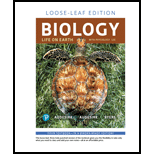
Concept explainers
Introduction:
There are clusters of specialized cells present in the hypothalamus which are known as neurosecretory cells. Thin fibers or axons are grown by neurosecretory cells which end in capillary bed and connect hypothalamus to anterior lobe of the pituitary. The neurosecretory cells produce six different regulatory hormones which can be either releasing or inhibiting hormones.
Answer to Problem 1MC
Correct answer:
The neurosecretory cells in the hypothalamus produce hormones which are involved in the reabsorption of water by the kidney. Therefore, option (c) is correct.
Option (c) is given as “produce hormones that regulate water reabsorption in the kidney”.
Explanation of Solution
Justify reasons for the correct statement:
The neurosecretory cells of the hypothalamus are involved in the synthesis of peptide hormones, their storage, and release. The neurosecretory cells produce antidiuretic hormone and oxytocin hormone. The antidiuretic hormone maintains blood pressure, tissue water, and volume of blood by regulating the amount of water and thereby controlling the concentration of urine.
Hence, option (c) is correct.
Justify reasons for the incorrect statements:
Option (a) is given as “release growth hormone and prolactin”.
The growth hormone and prolactin are released by the anterior lobe of the pituitary. Prolactin stimulates the development of mammary glands and growth hormone stimulates the growth of bone and increases synthesis of proteins. These hormones are not released by neurosecretory cells. Hence, it is a wrong answer.
Option (b) is given as “release hormones that control hormone secretion by cells in the posterior pituitary”.
The neurosecretory cells in the hypothalamus release six different regulatory hormones. All these hormones regulate the release of hormones from the anterior lobe of the pituitary. The hormones released by neurosecretory cells do not regulate hormonal secretion of posterior pituitary. Hence, it is a wrong answer.
Option (d) is given as “produce hormones that stimulate glucose uptake by muscle cells”.
The hormone which stimulates the uptake of glucose by muscle cells is insulin. Insulin is produced by beta cells of the pancreas and not neurosecretory cells in the hypothalamus. Hence, it is a wrong answer.
Hence, options (a), (b), and (d) are incorrect.
The neurosecretory cells in hypothalamus form axons which end in the capillary bed in the stalk which connects hypothalamus to anterior lobe of the pituitary. These cells secrete six different regulatory hormones which regulate the hormonal secretion of the anterior pituitary. Apart from these six hormones, neurosecretory cells also release oxytocin and antidiuretic hormone. The antidiuretic hormone regulates the reabsorption of water by the kidney.
Want to see more full solutions like this?
Chapter 38 Solutions
Pearson eText Biology: Life on Earth with Physiology -- Instant Access (Pearson+)
- What symbolic and cultural behaviors are evident in the archaeological record and associated with Neandertals and anatomically modern humans in Europe beginning around 35,000 yBP (during the Upper Paleolithic)?arrow_forwardDescribe three cranial and postcranial features of Neanderthals skeletons that are likely adaptation to the cold climates of Upper Pleistocene Europe and explain how they are adaptations to a cold climate.arrow_forwardBiology Questionarrow_forward
- ✓ Details Draw a protein that is embedded in a membrane (a transmembrane protein), label the lipid bilayer and the protein. Identify the areas of the lipid bilayer that are hydrophobic and hydrophilic. Draw a membrane with two transporters: a proton pump transporter that uses ATP to generate a proton gradient, and a second transporter that moves glucose by secondary active transport (cartoon-like is ok). It will be important to show protons moving in the correct direction, and that the transporter that is powered by secondary active transport is logically related to the proton pump.arrow_forwarddrawing chemical structure of ATP. please draw in and label whats asked. Thank you.arrow_forwardOutline the negative feedback loop that allows us to maintain a healthy water concentration in our blood. You may use diagram if you wisharrow_forward
- Give examples of fat soluble and non-fat soluble hormonesarrow_forwardJust click view full document and register so you can see the whole document. how do i access this. following from the previous question; https://www.bartleby.com/questions-and-answers/hi-hi-with-this-unit-assessment-psy4406-tp4-report-assessment-material-case-stydu-ms-alecia-moore.-o/5e09906a-5101-4297-a8f7-49449b0bb5a7. on Google this image comes up and i have signed/ payed for the service and unable to access the full document. are you able to copy and past to this response. please see the screenshot from google page. unfortunality its not allowing me attch the image can you please show me the mathmetic calculation/ workout for the reult sectionarrow_forwardIn tabular form, differentiate between reversible and irreversible cell injury.arrow_forward
 Concepts of BiologyBiologyISBN:9781938168116Author:Samantha Fowler, Rebecca Roush, James WisePublisher:OpenStax College
Concepts of BiologyBiologyISBN:9781938168116Author:Samantha Fowler, Rebecca Roush, James WisePublisher:OpenStax College Human Physiology: From Cells to Systems (MindTap ...BiologyISBN:9781285866932Author:Lauralee SherwoodPublisher:Cengage LearningEssentials of Pharmacology for Health ProfessionsNursingISBN:9781305441620Author:WOODROWPublisher:Cengage
Human Physiology: From Cells to Systems (MindTap ...BiologyISBN:9781285866932Author:Lauralee SherwoodPublisher:Cengage LearningEssentials of Pharmacology for Health ProfessionsNursingISBN:9781305441620Author:WOODROWPublisher:Cengage Medical Terminology for Health Professions, Spira...Health & NutritionISBN:9781305634350Author:Ann Ehrlich, Carol L. Schroeder, Laura Ehrlich, Katrina A. SchroederPublisher:Cengage Learning
Medical Terminology for Health Professions, Spira...Health & NutritionISBN:9781305634350Author:Ann Ehrlich, Carol L. Schroeder, Laura Ehrlich, Katrina A. SchroederPublisher:Cengage Learning





